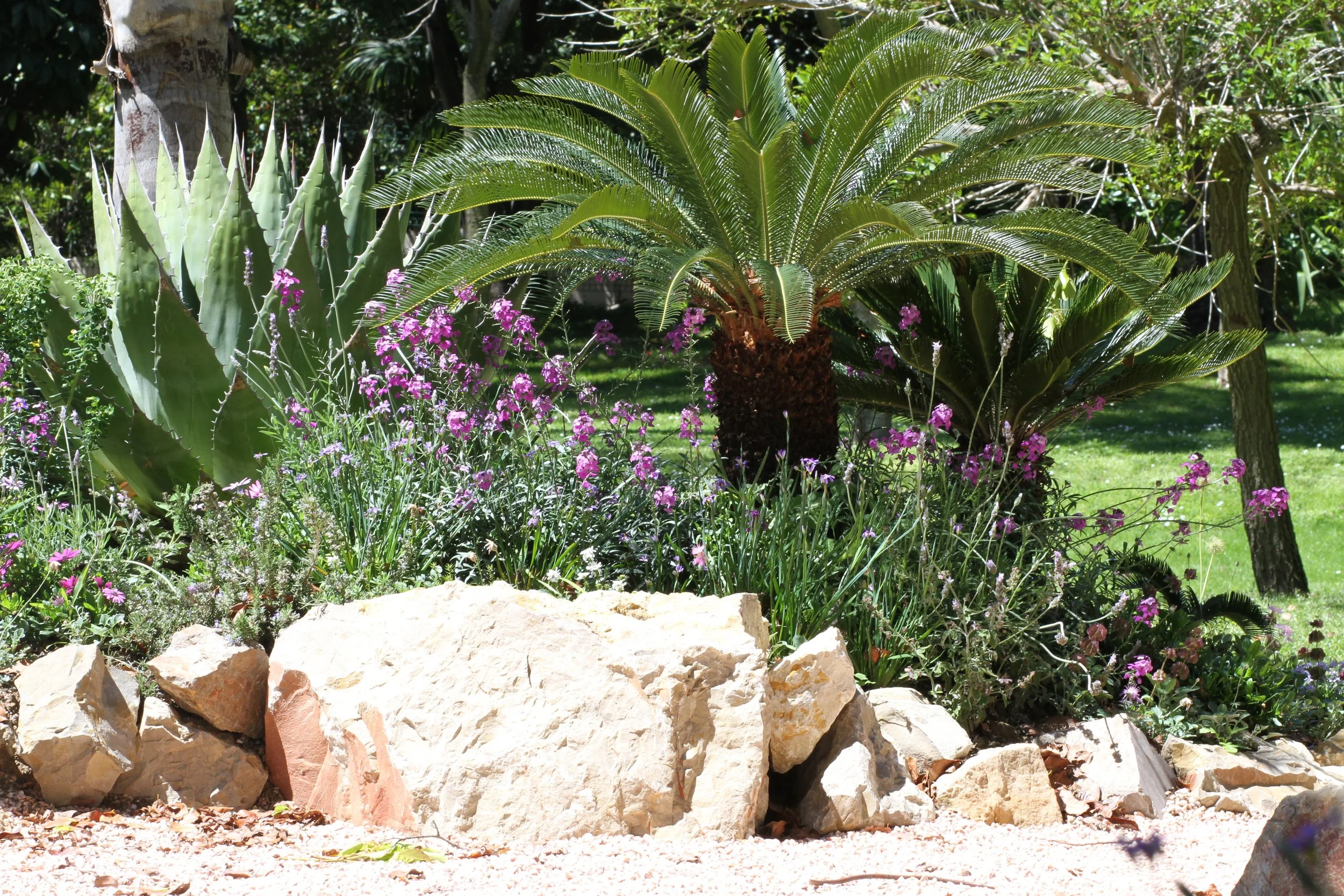
Drough-Tolerant and Xerophile Garden
Definition & Advice
What is a drought-tolerant garden? What plants? What is the difference with a Mediterranean or Japanese garden?
Here are our tips.
What is a Drought-Tolerant Landscape?
There are many ways to create a garden, but one of them is more popular than the others: the dry garden or the drought-tolerant garden. Indeed, this type of garden requires very little maintenance and less watering. It is generally composed of sand, moss, rocks, decorative gravel, and especially drought-resistant plants called xerophilous plants.
In recent years, the dry garden has become more democratic thanks in large part to its resistance to drought and increasingly regular heat waves. It therefore requires less attention in terms of maintenance while proposing a very great ecological interest. Its advantages have made this garden a real star of the flowerbeds of houses.
Dry gardens can come in several types depending on the components used.
The Different Types of Drought-Tolerant Gardens
There are therefore several types of drought-tolerant gardens: Mediterranean dry gardens, Japanese dry gardens and desert gardens. Here is a brief overview of each of them.
The Drought-tolerant Mediterranean Garden
The design of a dry Mediterranean garden is based on Mediterranean trends and the plants that grow there. The climate is rather windy, warm and dry: it is then preferable to opt for resistant plants adapted to a dry soil, poor in organic matter and stony.
The plants for a dry Mediterranean garden are therefore grasses, rosemary, sage, lavender or strawberry. As you can see, the plants for a dry Mediterranean garden are as beautiful as they are fragrant, so you have a garden with a thousand smells !
2. Japanese Dry Mineral Garden
The Japanese garden is generally associated with a desire for «zen», relaxation. There is a real connection between each mineral and plant element. This is the reason why Japanese gardens contemplate themselves: they are rarely conceived as playgrounds.
There is usually a central element such as a fountain or a statue. Around it, stones, gravel and sand can serve as small paths, but also allow to play on the colors. The important thing for this type of garden is to transfer the energy in a fluid way using a course designed beforehand, composed of plants and minerals. For example, white pebble and slate beds can be passages.
Japanese gardens are quite resilient to cold winters. However, wind is not recommended for this type of achievement, at the risk of unbalancing the implementation of each element. It is therefore advisable to turn towards a dry Mediterranean garden if you live in a windy region.
3. Desert and xerophile Garden
Desert gardens are composed of plants that we are not used to seeing in our temperate climates. Of Middle Eastern inspiration, they do not require important maintenance, and transport you in an exotic atmosphere. Xerophile plants are defined as plants that grow at low water activity (wa) levels. This means that xerophile plants prefer to have less water and therefore can survive in aride landscapes.
The realization of the desert gardens is done mainly with stones, rocks, sand, wood and grass plants. Among these is the famous herb of the pampa, but we do not use it because it is invasive, preferring the stipa, which brings sweetness and cheerfulness to the garden. Fatty plants also refer to the desert, such as agave, sedum, aloe vera, cacti and yuccas. You can also find paths dotted with small pebbles, fragments of rocks and blocks of stone, reminiscent of the desert.
What plants for a drought-tolerant garden ?
For a drought-tolerant garden that requires little maintenance, several types of plants are usually used. But it also depends on the desires of each and the desired atmosphere. For a Mediterranean style, we recommend aromatic plants, lavender, cistus, thyme, rosemary, sage and santoline. For a rather Japanese model, you can find bamboos, Niwaki trees, Japanese maples or bonsai trees. And finally, for a more desert atmosphere, cacti and ornamental plants are quite suitable.
What minerals for a drought-tolerant garden ?
To achieve a drought-tolerant garden, we recommend adding minerals to your lawn to ensure drainage and drainage of rainwater. Because it is important to have a well draining soil. There are especially gravel - or decorative gravel, pebbles and rocks for example. It is also very interesting to play with the colors of these minerals to give different atmospheres. In France and in our neighbours, we have an exceptional diversity of colors and forms of minerals. We use the limestone of Paris, the blue slate of Cherbourg, the pink sandstone of the Vosges and the granite of Lozère, with which we propose natural enrochements.
Why use a landscaper for a drought-tolerant garden ?
At SIMONSON LANDSCAPE, we support you in the design and realization of your dry garden. For advice on plans or the complete realization of your Mediterranean garden, anything is possible. After listening carefully to your needs, we imagine the dry garden that meets your expectations, but also meets the constraints of your outdoor space. Following this step, we are then able to design and realize your dry garden. You thus have an expert vision of your garden that meets both your aesthetic criteria but also the technical requirements of your space.
SIMONSON LANDSCAPE, specialist in dry gardens, received the “Prix de la palette végétale” in Chaumont-sur-Loire (41), the Audience Prize at the Côte d'Azur Festival at Villa Rothschild in Cannes (06), and the Special Jury Prize of the European Garden Heritage Network (EGHN) with the Terres de Promesses garden for the Jardins de la Paix in Souain-Perthes-lès-Hurlus (51) with Arts & Jardins Hauts-de-France.
Do not hesitate to contact us, we will be happy to answer your questions and accompany you on your drought-tolerant garden project !
A few of our dry gardens






Now let's talk about you.
Everything starts with an idea, a desire.
What is yours?


